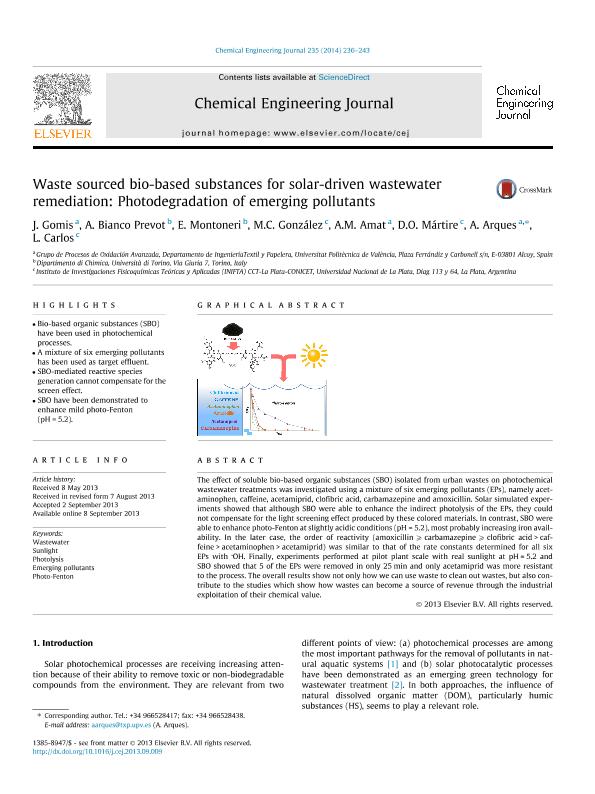Artículo
Waste sourced bio-based substances for solar-driven wastewater remediation: Photodegradation of emerging pollutants
Gomis, J.; Bianco Prevot, A.; Montoneri, E.; Gonzalez, Monica Cristina ; Amat, A. M.; Martire, Daniel Osvaldo; Arques, A.; Carlos, Luciano
; Amat, A. M.; Martire, Daniel Osvaldo; Arques, A.; Carlos, Luciano
 ; Amat, A. M.; Martire, Daniel Osvaldo; Arques, A.; Carlos, Luciano
; Amat, A. M.; Martire, Daniel Osvaldo; Arques, A.; Carlos, Luciano
Fecha de publicación:
01/2014
Editorial:
Elsevier
Revista:
Chemical Engineering Journal
ISSN:
1385-8947
Idioma:
Inglés
Tipo de recurso:
Artículo publicado
Clasificación temática:
Resumen
The effect of soluble bio-based organic substances (SBO) isolated from urban wastes on photochemical wastewater treatments was investigated using a mixture of six emerging pollutants (EPs), namely acetaminophen, caffeine, acetamiprid, clofibric acid, carbamazepine and amoxicillin. Solar simulated experiments showed that although SBO were able to enhance the indirect photolysis of the EPs, they could not compensate for the light screening effect produced by these colored materials. In contrast, SBO were able to enhance photo-Fenton at slightly acidic conditions (pH = 5.2), most probably increasing iron availability. In the later case, the order of reactivity (amoxicillinPcarbamazepine Pclofibric acid > caffeine > acetaminophen > acetamiprid) was similar to that of the rate constants determined for all six EPs with OH. Finally, experiments performed at pilot plant scale with real sunlight at pH = 5.2 and SBO showed that 5 of the EPs were removed in only 25 min and only acetamiprid was more resistant to the process. The overall results show not only how we can use waste to clean out wastes, but also contribute to the studies which show how wastes can become a source of revenue through the industrial exploitation of their chemical value.
Palabras clave:
Wastewater
,
Sunlight Photolysis
,
Emerging Pollutants
,
Photo-Fenton
Archivos asociados
Licencia
Identificadores
Colecciones
Articulos(INIFTA)
Articulos de INST.DE INV.FISICOQUIMICAS TEORICAS Y APLIC.
Articulos de INST.DE INV.FISICOQUIMICAS TEORICAS Y APLIC.
Articulos(SEDE CENTRAL)
Articulos de SEDE CENTRAL
Articulos de SEDE CENTRAL
Citación
Gomis, J.; Bianco Prevot, A.; Montoneri, E.; Gonzalez, Monica Cristina; Amat, A. M.; et al.; Waste sourced bio-based substances for solar-driven wastewater remediation: Photodegradation of emerging pollutants; Elsevier; Chemical Engineering Journal; 235; 1-2014; 236-243
Compartir
Altmétricas



